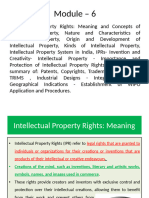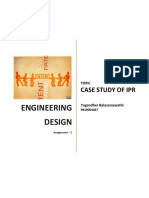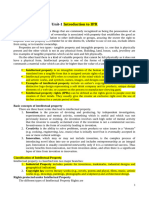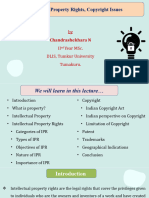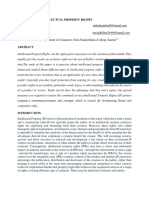Module 5 Notes
Uploaded by
mdkatak1002Module 5 Notes
Uploaded by
mdkatak1002Research Methodology 1
MODULE-5
IPRs- INVENTION AND CREATIVITY
IPRs-Invention and Creativity-Intellectual Property-Importance and Protection
of Intellectual Property Rights (IPRs)-A brief summary of: Patents, Copyrights,
Trademarks, Industrial Designs- Integrated Circuits-Geographical Indications-
Establishment of WIPO-Application and procedures.
INVENTION AND CREATIVITY
An invention may be defined as the idea of making a new and useful article, method or
substance.
Invention is the creation of something that has never been made before and is
recognized as the product of some unique insight.
Creativity is the capability or act of conceiving something original or
unusual. Innovation is the implementation of something new.
INTELLECTUAL PROPERTY
Intellectual Property (IP) refers to intellectual (original) creativity of a creator. IP are
inventions, literary and artistic works (books, music and paintings), technical or scientific
creation, designs, symbols, names and images.
1. Intellectual property is an asset of a person.
2. It is a legal concept which refers to creations of the mind for which exclusive rights
are recognized.
3. The owner has the right to prevent the unauthorized use or sale of the property.
4. It is intangible. It cannot be defined or identified by its own physical parameters.
Thus an intellectual property must be expressed in some discernible way for
enabling it to be protected.
INTELLECTUAL PROPERTY RIGHTS (IPRs)
Definitions
Intellectual property rights (IPRs) refers to the legal rights given to the inventor or
creator to protect their invention or creation for a certain period of time. Also, (IPRs)
enable them to reap commercial benefits from their creative efforts or reputation. Or
Girish H, Assoc. Prof., Dept. of ECE, CiTech.
Research Methodology 2
IPR is a strong tool, to protect investments, time, money, effort invested by the
inventor/creator of an IP, since it grants the inventor/creator an exclusive right for a
certain period of time for use of his invention/creation. Or
These legal rights confer an exclusive right to the inventor/creator or his assignee to
fully utilize his invention/creation for a given period of time.
IMPORTANCE AND PROTECTION OF INTELLECTUAL PROPERTY RIGHTS
(IPRs)
Importance of IPR
The knowledge of intellectual property rights is must to a common man. The intellectual
property rights were essentially recognized and accepted all over the world. Under
intellectual property law, owners are granted certain exclusive rights to a variety of
intangible assets, such as musical, literary and artistic works; discoveries and inventions;
words, phrases, symbols and designs. Intellectual property has economic value and is
protected or protectable by law intellectual property rights. Some of the reasons for
accepting these rights are
The objectives of Intellectual property rights are to grant incentive to the creator of a
work.
IPRs play very important role in the progress and development of the society by
promoting healthy competition and encouraging industrial development and
economic growth.
Under these rights, Intellectual property can be bought, sold, licensed or
exchanged. IPR enhances technology advancement in the following ways:
(a) It provides a mechanism of handling infringement, piracy, and unauthorized
use.
(b) It provides a pool of information to the general public since all forms of IP
are published except in case of trade secrets.
Protection of IPR
These IPR laws provided a protection to the owners under different categories and names
like Patents, Industrial designs, Copyrights, Trade-Marks etc.
Girish H, Assoc. Prof., Dept. of ECE, CiTech.
Research Methodology 3
TYPES OF INTELLECTUAL PROPERTY RIGHTS
The common types of Intellectual property rights are: patents, copyright, trademarks,
industrial design, trademarks, trade secrets, geographical indicators and layout design for
Integrated Circuits and even ideas.
Intellectual property rights may be divided into two main categories: industrial
property rights and literary/artistic property rights.
1. Industrial property rights
Industrial property rights concern creations which play an economic role in
production and distribution processes.
Certain innovations such as inventions, medicines, new plant varieties or a new
design, which may be protected by patents, plant variety rights and design
rights respectively.
Industrial property rights may also apply to distinctive signs such as trademarks
or geographical indications. While they are not true intellectual property rights,
trade names and legal names also benefit from certain kinds of protection.
Most industrial property rights are obtained after a formal procedure, generally
consisting of registration, while copyrights and related rights emerge
automatically at the time of creation.
2. Literary/Artistic property rights
Literary and artistic property includes copyrights and related rights, including
music, literary works, paintings, sculptures, photographs, artistic interpretations,
radio broadcasts, etc.
Intellectual property rights (intellectual rights)
Industrial property Literary/Artistic property
Patent rights Copyright
Trademarks Related rights
Design rights Database rights
Plant variety rights
Geographical indications
Topographies of semiconductor products
Girish H, Assoc. Prof., Dept. of ECE, CiTech.
Research Methodology 4
A BRIEF SUMMARY OF PATENTS, COPYRIGHTS, TRADEMARKS, AND
INDUSTRIAL DESIGNS
IP protection can be sought for a variety of intellectual efforts including
A PATENT
“A patent is awarded for an invention which satisfies the criteria of global novelty, non-
obviousness and industrial or commercial application”.
“A patent is an exclusive right granted for an invention, which is a product or a process that
provides a new way of doing something, or offers a new technical solution to a problem”.
Patent protection means that the invention cannot be commercially made, used,
distributed or sold without the patent owner's consent.
A patent owner has the right to decide who may or may not use the patented
invention for the period in which the invention is protected.
The patent owner may give permission to, or license, other parties to use the
invention on mutually agreed terms.
He may also sell the right to the invention to someone else, who will then become
the new owner of the patent.
A Patent is granted for a period of 20 years from the date of filing the application of
patent.
Once a patent expires, the protection ends, and an invention enters the public
domain, that is, the owner no longer holds exclusive rights to the invention.
No product patents were granted for drugs and food items.
The Patents Act- 1970 -Amended in 1999, 2002 and 2005
Patents Rules- 2003- Amended in 2005, 2006
Patent Administration in India: The Head Office is in Kolkata. Four branches: Kolkata,
Mumbai, Delhi and Chennai
COPYRIGHT
Copyright is a legal term describing the rights given to creators for their literary and artistic
works. A copyright holder has certain exclusive rights. These exclusive rights include:
Copyright may apply to a wide range of creative, intellectual, or artistic forms, or
works.
Girish H, Assoc. Prof., Dept. of ECE, CiTech.
Research Methodology 5
The works covered by copyright include literary works such as novels, poems,
plays, reference works, newspapers and computer programs; databases; films,
musical compositions, and choreography; artistic works such as paintings, drawings,
photographs and sculpture; architecture; and advertisements, maps and technical
drawings.
The reproduction in various forms such as copying, printing, recording, public
performance or adaptation are prohibited under these rights.
Copyright does not cover ideas and information themselves, only the form or
manner in which they are expressed.
This right provides economic right to the creator that is the financial benefit for a
period lasting of fifty years after the creator's death.
It is important to realize that copyrights do not protect ideas, only how they're
expressed.
AN INDUSTRIAL DESIGN
An industrial design consists of the creation of a shape, configuration or composition of
pattern or color, or combination of patterns and colors in three dimensional forms,
containing aesthetic value.
It can be a two or three dimensional pattern, used to produce a product.
Even the traditional craft items like hand-woven articles like carpets, cotton bed
covers can also be registered for protection as an Industrial design (Kannan, 2010).
The design has to be registered against imitation and unauthorized copying.
The protection is provided for five years and it can be renewed for fifteen years.
TRADEMARK [BRAND]
Trademarks relate to any mark, name, sign, design or logo. A trademark protects symbolic
information that relates to goods or services. A trademark prevents competitors from using
the same symbol. The trademark must be used in commerce.
Trademarks can be bought, sold, and licensed.
Trademarks protect the names and identifying marks of products and companies.
It can be patented like invention and industrial designs.
Girish H, Assoc. Prof., Dept. of ECE, CiTech.
Research Methodology 6
The trade mark can be a combination of words, letters, numbers, drawings, images,
symbols and even sounds.
These are generally registered for seven years but they can be renewed indefinitely
by applying again.
It helps consumers identify and purchase a product or service because of its nature
and quality, indicated by its unique trademark.
The system helps consumers to identify and purchase a product or service based on whether
its specific characteristics and quality – as indicated by its unique trademark – meet their
needs
What kinds of trademarks can be registered?
Trademarks may be one or a combination of words, letters and numerals.
They may consist of drawings, symbols or three dimensional signs, such as the
shape and packaging of goods.
In some countries, non-traditional marks may be registered for distinguishing features
such as holograms, motion, color and non-visible signs (sound, smell or taste).
TRADE SECRET
A trade secret is a formula, practice, process, design, instrument, pattern or compilation of
information which is not generally known or reasonably ascertainable by which a business
can obtain an economic advantage over competitors or customers.
It may be confidential business information that provides an enterprise a competitive
edge.
Trade secrets include sales methods, distribution methods, consumer profiles,
advertising strategies, lists of suppliers and clients and manufacturing processes.
A trade secret can be protected for an unlimited period of time but a substantial
element of secrecy must exist, so that, except by the use of improper means, there
would be difficulty in acquiring the information.
Advantages of trade secrets
No need to register
Not limited in time
No disclosure
Can protect unpatentable information
Girish H, Assoc. Prof., Dept. of ECE, CiTech.
Research Methodology 7
Disadvantages of trade secrets
Costs of keeping it secret can be high
Others may discover/invent it independently
Others may patent it (if patentable)
If the secret is embodied in a product it may be reverse engineered
More difficult to enforce
GEOGRAPHICAL INDICATORS (GI)
A geographical indication (GI) is a name or sign used on certain products. A sign used on goods
that have a specific geographical location or origin (e.g. a town, region, or country). The use of
a GI may act as a certification that the product possesses certain qualities, is made according to
traditional methods, or enjoys a certain reputation, due to its geographical origin. Geographical
indicators are the signs used on goods that have a specific geographical origin.
A GI indicates that a product comes from a certain place and has special qualities
due to that place of origin which could be a village or town, a region or a country.
It is an exclusive right given to a particular community and thus the benefits of its
registration are shared by the all members of the community.
It may be used by all producers or traders whose products originate from that place
and which share typical characteristics.
Ex.: Bordeaux (wine), Darjeeling (tea), Chanderi (sarees), Kullu shawls and
Tuscany (olive oil).
Most commonly, a geographical indication consists of the name of the place of
origin of the goods – Ex.: Champagne.
In some countries: can also be figurative element – Ex.: Eiffel tower.
Difference between a Trademark and a Geographical
Indication Trademark
A trademark is a sign used by a company to distinguish its goods and services from
those produced by others.
It gives its owner the right to prevent others from using the trademark.
A GI informs consumers that a product comes from a certain place and has special
qualities due to that place of origin.
Girish H, Assoc. Prof., Dept. of ECE, CiTech.
Research Methodology 8
Geographical Indication
A GI may be used by all producers or traders whose products originate from that place and
which share typical characteristics.
A GI must be protected in its country of origin.
INTEGRATED CIRCUITS
Semiconductor Integrated Circuit is a product, having transistors and other circuitry
elements, which are inseparably formed on a semiconductor material or an
insulating material.
The initial term of registration is for 10 years; thereafter it may be renewed from
time to time.
INTEGRATED CIRCUIT LAYOUT
WHAT IS A LAYOUT-DESIGN OF AN INTEGRATED CIRCUIT
Integrated circuit layout, also known IC layout, IC mask layout, or mask design. A layout-
design of an integrated circuit is the three-dimensional character of the elements and
interconnections of an integrated circuit.
An integrated circuit (IC) is an electronic circuit in which the elements of the circuit
are integrated into a medium, and which functions as a unit.
Currently the medium used to create this unit is a solid semiconductor such as
silicon. The circuit is integrated into the piece of silicon, commonly called a "chip"
or a "silicon chip".
The terms "integrated circuit", "semiconductor" and "silicon chip" are used
synonymously as commercial ICs are usually fabricated from silicon semiconductors.
1. Term of protection
The law that protects layout-designs of integrated circuits is the Layout-designs of
A layout-design shall be protected under this Act for a period of ten years from the
date the layout-design is first commercial exploitation anywhere in the world. A layout-design is
eligible for protection automatically upon fulfillment of the following conditions:
It is original, i.e. the result of its creator's own intellectual effort and not
commonplace among creators and manufacturers of integrated circuit;
It has been fixed in a material form or incorporated into an integrated circuit;
Girish H, Assoc. Prof., Dept. of ECE, CiTech.
Research Methodology 9
The right holder of the layout-design is a qualified person.
The creator;
The person who commission if the layout-design is created in pursuance of a
commission;
The employer if the layout-design is created by an employee in the course of his employment.
2. Rights of right holder
A right holder of a protected layout-design has the following rights:
Reproduce and to authorize the reproduction of his protected layout-design;
To commercially exploit and to authorize the commercial exploitation* of
: O His protected layout-design;
O An integrated circuit in which the layout-design is incorporated; or
O An article that contains an integrated circuit in which the layout-design is
incorporated.
*Commercial exploitation includes selling, letting for hire, or otherwise distributing by way of trade, and
importation for these purposes.
ADMINISTRATION OF IPRs
Patents, Designs and Trademarks and geographical indications are administered by the
Controller General.
1. It is under the control of the Department of Industrial Policy and Promotion,
Ministry of Commerce and Industry.
2. Copyright is under the charge of the Ministry of Human Resource Development.
3. The Act on Layout-Design of Integrated Circuits is administered by the Ministry of
Telecommunication and Information Technology.
4. Protection of Plant Varieties and Farmers’ Rights Authority, Ministry of Agriculture
administers the Act on Plant Variety.
WORLD INTELLECTUAL PROPERTY ORGANISATION (WIPO)
Establishment of WIPO-application and procedures
Word Intellectual Property Organisation (WIPO) is an International Organisation, responsible
for the promotion of the protection of intellectual property throughout the world. (WIPO) was
established in 1970 as an agency of the United Nations. Since then the term really began to be
Girish H, Assoc. Prof., Dept. of ECE, CiTech.
Research Methodology 10
used in the United States. The inventors and authors are therefore recognized and rewarded
for their ingenuity.
India is a member state of World Intellectual Property Organisation (WIPO).
OBJECTIVES AND MAIN ACTIVITIES OF WIPO
WIPO is the United Nations specialised agency that coordinates international
treaties regarding intellectual property rights.
Its 184 member states comprise over 90% of the countries of the world includes
experts in diverse areas of IP law and practice, as well as specialists in public policy,
economics, administration, and IT.
. Member states participate in WIPO to negotiate treaties and set policy on
intellectual property matters such as patents, copyrights and trademarks.
WIPO was established in 1967 by the WIPO Convention, which states that WIPO’s
objective was to promote the protection of intellectual property throughout the world
(WIPO, 1967, Article 3).
By providing a stable environment for marketing products protected by intellectual
property, it also oils the wheels of international trade.
Headquartered in Geneva, Switzerland, WIPO currently administers 24 treaties and
facilitates the negotiation of several proposed treaties covering copyrights, patents
and trademarks
WIPO Led by a Director-General, Mr. Francis Gurry since October 1, 2008. He was
reappointed in May 2014 for a second six-year term, which runs through September
2020. WIPO has a staff of some 1238 from 116 countries.
April 26, WIPO joints IP Offices and organizations around the world in celebrating
World IP Day.
Francis Gurry has led WIPO as Director General since October 1, 2008. He was
reappointed in May 2014 for a second six-year term, which runs through September
2020.
Under his leadership, WIPO is addressing major challenges. These include managing
the stress on the international patent and copyright systems produced by rapid
technological change, by globalization and increased demand; reducing the
knowledge gap between developed and developing countries; and ensuring that the
Girish H, Assoc. Prof., Dept. of ECE, CiTech.
11
intellectual property (IP) system serves its fundamental purpose of encouraging
creativity and innovation in all countries.
To equip WIPO to meet these evolving challenges, Francis Gurry has led a
comprehensive program of organizational change, realigning WIPO’s programs,
resources and structures with re-defined strategic goals.
ACTIVITIES BY UNIT
WIPO's organizational structure is based on seven Sectors, each headed by a Deputy
Director General (DDG) or Assistant Director General (ADG), under the overall leadership
of the Director General.
Each Sector comprises several units, usually called Divisions or Departments (shown
below), and led by Directors. These are responsible for delivering the programs and
activities approved by member states in the Program and Budget.
PROCUREMENT
WIPO procures goods and services from suppliers around the globe. Methods of solicitation
may be formal or informal, based on the WIPO Financial Regulations and Rules and the
WIPO General Procurement Principles. Our major objective is to obtain the best value for
money through a transparent and fair procurement process.
MEMBER STATES
WIPO’s member states determine the direction, budget and activities of the Organization
through the decision-making bodies. We currently have 188 member states. To become a
member, a state must deposit an instrument of ratification or accession with the Director
General.
The WIPO provides that membership is open to any state that is:
A member of the Paris Union for the Protection of Industrial Property, or member of
the Berne Union for the Protection of Literary and Artistic Works; or
A member of the United Nations, or of any of the United Nations' Specialized
Agencies, or of the International Atomic Energy Agency, or that is a party to the
Statute of the International; or
Invited by the WIPO General Assembly to become a member state of the
Organization. Director General Francis Gurry
Girish H, Assoc. Prof., Dept. of ECE, CiTech.
12
INTERNSHIP AND A FELLOWSHIP PROGRAM
WIPO runs a Summer Internship program. The objective is to provide an opportunity for
senior students and young professionals to acquire a working knowledge of intellectual
property and to be exposed to the work of the Organization, including its treaty-making,
international registration, research and publication activities. The WIPO Internship Program
is open to
1. students of intellectual property or other branches of law,
2. young professionals with an intellectual property background,
3. graduates in other related fields of interest to WIPO.
Ex.:Scienceandtechnology,finance,humanresources,economics,
communications, IT, international relations, etc., from any region in the world.
Interns under this scheme are recruited for an initial period of three months, which
may be extended to a maximum of six months. Requirements are:
Age 21 years to 32 years
Graduate or post-graduate student at the time of application
Fluent English or French and working knowledge of the other language
Proficient computer skills (Word, Excel, PowerPoint, and other relevant IT
programs)
A demonstrable track record of achievement, supported by copies of diplomas or
certificates from university and other specialized institutions.
WIPO, 34, chemin des Colombettes,
1211 Geneva 20,
Switzerland.
Fax: (4122) 338 98 20;
e-mail: staffengagements@wipo.int
Link http://www.wipo.int/hr/en/
EMPLOYMENT OPPORTUNITIES
How to Apply
All applications for employment opportunities at WIPO must now be made via the WIPO's
e-Recruitment system.
Access WIPO's e-Recruitment system
Girish H, Assoc. Prof., Dept. of ECE, CiTech.
13
WIPO's e-Recruitment system offers the following advantages for applicants:
On-line system for submitting applications
Create a personal account for future visits
Return to view or update personal information at any time
Ability to apply to multiple vacancy notices
Upload additional information (i.e. cover letter, CV, photo, publications and
other relevant documents)
Monitor the status of already submitted applications
Receive automated e-mail correspondence regarding the selection process
Online Application Procedures
Any individual interested in Professional and Higher Categories, General Service or
Internship Opportunities at WIPO should submit his/her application through the WIPO's e-
Recruitment system and follow the below procedures:
View WIPO’s current list of vacancy notices
Select the vacancy notice for which you would like to apply
If you are a first time applicant, you will be required to create a new personal account
All registered applicants must log in as Returning Applicants and complete the
mandatory details in the personal history sections
After the personal history sections are completed, applicants will be able to apply to
a specific vacancy
All applications must be submitted before the vacancy notice closing deadline
Applications will be acknowledged automatically. Applicants will be informed
throughout the recruitment process
All inquiries regarding the online application process should be addressed to
erecruit@wipo.int
All selected candidates must sign the WIPO Internship Agreement before beginning their
internship.
The forms may be obtained from our website at the following address:
www.wipo.int or
The Human Resources Engagement and Development
Section, WIPO, 34, chemin des Colombettes, 1211 Geneva
20,
Switzerland.
Girish H, Assoc. Prof., Dept. of ECE, CiTech.
14
Fax: + 41 22 338 98 20;
e-mail: staff.engagements@wipo.int
KEY MEMBERS/PARTICIPANTS AND DECISION-MAKING STRUCTURES
WIPO is made up of 184 member states and operates on a “one country, one vote” basis.
1. It is governed by a General Assembly, which convenes each autumn and oversees
the activities of the organisation, including its budget, while a number of issue-
specific committees work on the substantive issues
2. The revenues generated from patent and trademark fees enable WIPO to support a
staff of approximately 1,000 people, which is rather large by UN standards.
3. The agency operates through individual member states meeting in committees,
assemblies, and working groups, which are coordinated by the WIPO Secretariat.
4. Most member states appoint career civil servants from their capitals to participate in
meetings and negotiations.
5. WIPO committees work according to a consensus-based decision-making structure,
which generally means no action, is taken unless all member states agree.
6. WIPO’s strategic direction and activities are decided by the member states, but in
practice, the WIPO Secretariat, based in Geneva, is given enormous power to
influence and direct the work and objectives of the organisation under the WIPO
Convention.
FUNDING FOR WIPO
WIPO is a largely self-financed organization, generating more than 90 percent of its annual
budget through its widely used international registration and filing systems, as well as
through its publications and arbitration and mediation services. The remaining funds come
from contributions by Member States.
***********
Girish H, Assoc. Prof., Dept. of ECE, CiTech.
You might also like
- The First 100 Days in Office of Barangay Officials88% (16)The First 100 Days in Office of Barangay Officials2 pages
- Why Is Franchising A Popular Way To Expand Distribution of An Effective Service ConceptNo ratings yetWhy Is Franchising A Popular Way To Expand Distribution of An Effective Service Concept2 pages
- SWOT Analysis - Potential Future of The Three Lines ModelNo ratings yetSWOT Analysis - Potential Future of The Three Lines Model21 pages
- All You Want To Know About Intellectual PropertyNo ratings yetAll You Want To Know About Intellectual Property11 pages
- IPR-Intellectual Property Rights: Trade MarksNo ratings yetIPR-Intellectual Property Rights: Trade Marks5 pages
- Swami Vivekanand Subharti University, Meerut, U.P.: Assistant Professor: - Mrs. Mahima GargNo ratings yetSwami Vivekanand Subharti University, Meerut, U.P.: Assistant Professor: - Mrs. Mahima Garg15 pages
- Intellectual Property Rights PPT Oct 1922No ratings yetIntellectual Property Rights PPT Oct 192256 pages
- INTELLECTUAL PROPERTY RIGHTS AND INFORMATION TECHNOLOGY LAW- Part INo ratings yetINTELLECTUAL PROPERTY RIGHTS AND INFORMATION TECHNOLOGY LAW- Part I6 pages
- Intellectual Property Right: Met Institute of Computer Science PGDM - A (2019-2021)No ratings yetIntellectual Property Right: Met Institute of Computer Science PGDM - A (2019-2021)37 pages
- BR - MODULE - 3 Intellectual Property Rights and Information Technology Law PDFNo ratings yetBR - MODULE - 3 Intellectual Property Rights and Information Technology Law PDF20 pages
- All About Intellectual Property Rights (IPR) - IpleadersNo ratings yetAll About Intellectual Property Rights (IPR) - Ipleaders25 pages
- Importance of Intellectual Property RightsNo ratings yetImportance of Intellectual Property Rights5 pages
- Ipr Notes Sem 1 For Fybaf, Bbi, Bcom, BmsNo ratings yetIpr Notes Sem 1 For Fybaf, Bbi, Bcom, Bms55 pages
- Chapter - 1 Introduction To Intellectual Property RightsNo ratings yetChapter - 1 Introduction To Intellectual Property Rights3 pages
- CRITICAL STUDY ON INTELLECTUAL PROPERTY RIGHTSNo ratings yetCRITICAL STUDY ON INTELLECTUAL PROPERTY RIGHTS6 pages
- Intellectual Property and The Need To Protect It: Dushyant Kumar SharmaNo ratings yetIntellectual Property and The Need To Protect It: Dushyant Kumar Sharma4 pages
- Copyright, Patents, Trademarks and Trade Secret LawsFrom EverandCopyright, Patents, Trademarks and Trade Secret LawsNo ratings yet
- Part II. Chapter 3 Exemption From Real Property TaxesNo ratings yetPart II. Chapter 3 Exemption From Real Property Taxes30 pages
- THE North-East Frontier OF India: Captain ST John F MichellNo ratings yetTHE North-East Frontier OF India: Captain ST John F Michell401 pages
- Haryana Roadways Delhi Vs Rakesh Kumar and Anr.No ratings yetHaryana Roadways Delhi Vs Rakesh Kumar and Anr.14 pages
- Adamus - Cease and Desist - Allan Morrison LitigationNo ratings yetAdamus - Cease and Desist - Allan Morrison Litigation2 pages
- Thyssenkrupp Elevator (India) Pvt. LTD.: Purchase OrderNo ratings yetThyssenkrupp Elevator (India) Pvt. LTD.: Purchase Order2 pages
- BIR RULING NO. 317-92: Sycip, Gorres, Velayo & CoNo ratings yetBIR RULING NO. 317-92: Sycip, Gorres, Velayo & Co3 pages
- Conflict Dynamics: Galtung's Conflict TriangleNo ratings yetConflict Dynamics: Galtung's Conflict Triangle11 pages
- Margaret Thatcher and The End of Consensus, 1979-97 (From Page 142)No ratings yetMargaret Thatcher and The End of Consensus, 1979-97 (From Page 142)26 pages
- Download full (eBook PDF) The Audit Process, 7th Edition ebook all chapters100% (1)Download full (eBook PDF) The Audit Process, 7th Edition ebook all chapters55 pages
- The First 100 Days in Office of Barangay OfficialsThe First 100 Days in Office of Barangay Officials
- Why Is Franchising A Popular Way To Expand Distribution of An Effective Service ConceptWhy Is Franchising A Popular Way To Expand Distribution of An Effective Service Concept
- SWOT Analysis - Potential Future of The Three Lines ModelSWOT Analysis - Potential Future of The Three Lines Model
- Swami Vivekanand Subharti University, Meerut, U.P.: Assistant Professor: - Mrs. Mahima GargSwami Vivekanand Subharti University, Meerut, U.P.: Assistant Professor: - Mrs. Mahima Garg
- INTELLECTUAL PROPERTY RIGHTS AND INFORMATION TECHNOLOGY LAW- Part IINTELLECTUAL PROPERTY RIGHTS AND INFORMATION TECHNOLOGY LAW- Part I
- Intellectual Property Right: Met Institute of Computer Science PGDM - A (2019-2021)Intellectual Property Right: Met Institute of Computer Science PGDM - A (2019-2021)
- BR - MODULE - 3 Intellectual Property Rights and Information Technology Law PDFBR - MODULE - 3 Intellectual Property Rights and Information Technology Law PDF
- All About Intellectual Property Rights (IPR) - IpleadersAll About Intellectual Property Rights (IPR) - Ipleaders
- Chapter - 1 Introduction To Intellectual Property RightsChapter - 1 Introduction To Intellectual Property Rights
- Intellectual Property and The Need To Protect It: Dushyant Kumar SharmaIntellectual Property and The Need To Protect It: Dushyant Kumar Sharma
- Copyright, Patents, Trademarks and Trade Secret LawsFrom EverandCopyright, Patents, Trademarks and Trade Secret Laws
- Part II. Chapter 3 Exemption From Real Property TaxesPart II. Chapter 3 Exemption From Real Property Taxes
- THE North-East Frontier OF India: Captain ST John F MichellTHE North-East Frontier OF India: Captain ST John F Michell
- Adamus - Cease and Desist - Allan Morrison LitigationAdamus - Cease and Desist - Allan Morrison Litigation
- Thyssenkrupp Elevator (India) Pvt. LTD.: Purchase OrderThyssenkrupp Elevator (India) Pvt. LTD.: Purchase Order
- Margaret Thatcher and The End of Consensus, 1979-97 (From Page 142)Margaret Thatcher and The End of Consensus, 1979-97 (From Page 142)
- Download full (eBook PDF) The Audit Process, 7th Edition ebook all chaptersDownload full (eBook PDF) The Audit Process, 7th Edition ebook all chapters





